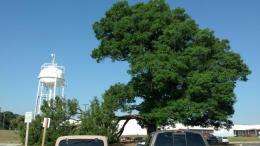'Tree of Life' still stands after Derecho

(Phys.org) -- The "Tree of Life" at NASA's Goddard Space Flight Center in Greenbelt, Md., took on the June 29 derecho and suffered some damage, but remains strong. The derecho brought winds of more than 80 mph in Maryland, and was a traumatic event for many people, animals, trees and structures. One of the tree's large limbs cracked and came down in the storm.
The giant willow oak tree that sits outside of Goddard's Exploration Sciences Building has become known as the "Tree of Life." The tree has sentimental value to some, and the parking lot for the building was even designed to accommodate it.
"This massive tree [The Tree of Life] represents what we do here at Goddard, looking out for Mother Earth," said Paul Thompson, general foreman in the Operations and Maintenance Branch at Goddard, and the roads and grounds facilities operations manager for the entire Goddard campus.
A derecho (pronounced "deh-REY-cho") is a widespread, long-lived wind storm that is associated with a band of rapidly moving showers or thunderstorms. Damage from a derecho is usually in one direction along a relatively straight track. By definition an event is classified a derecho if the wind damage swath extends more than 240 miles and includes wind gusts of at least 58 mph or greater along most of its length.
NASA Goddard's willow oak is considered a large specimen tree by the Maryland Forest Service, part of the Maryland Department of Natural Resources. The Chesapeake Bay Foundation of Maryland defines a specimen tree as having "a diameter of 30 inches or more, measured at 4.5 feet above the ground, or trees having 75 percent or more of the diameter of the current state champion tree." The State of Maryland keeps track of specimen trees and Goddard’s "Tree of Life" is one of those.
The willow oak is also known as quercus phellos. It is a deciduous tree in the red oak group of oaks and is native to eastern North America. They typically grow to a height of 50 to 100 feet, and their canopy spreads out to between 30 and 70 feet. It's a fast growing oak with willow-like foliage and a good shade tree, according to the Maryland Forest Service. It does well in full sun or semi-shade. NASA's "Tree of Life" is estimated to be between 175 and 200 years old.
Thompson said, "The arborist said that the tree needed to be cleaned up and trimmed. The downed section of the tree would need to be completely cut off. The arborists will treat the ground around the massive tree with an insecticide in an attempt of preventing insects from invading the exposed wound."
In the fall, tree maintenance specialists will return to bore holes in the ground and apply a special formulated fertilizer. This process was performed before the area was developed and a lightning rod and grounding cable was attached to help protect the tree from lighting damage.
Despite a life-changing event, NASA Goddard's symbolic tree of life continues to stand tall, and has weathered the storm.
Provided by NASA
















